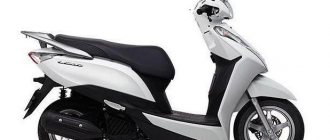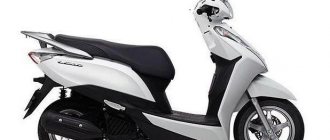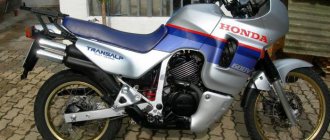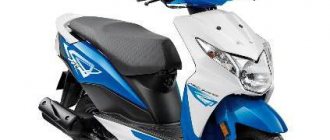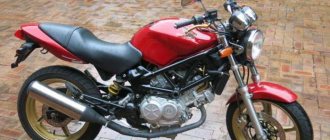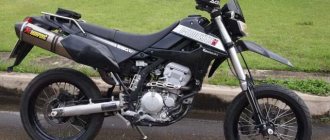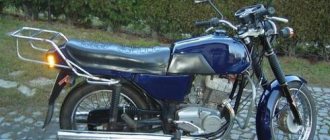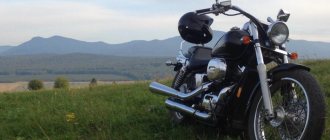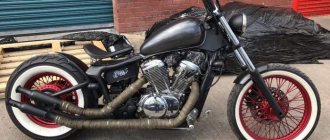Japanese motorcyclesHonda motorcycles
This is the easiest to handle super-heavy cruiser motorcycle. This is the pinnacle of conceptual thought embodied in a high-tech machine.
This is the best cruiser of all time. Any publication about this motorcycle must begin with a similar phrase.
What kind of supermotorcycle is this, without which not a single official review, not a single conversation among hardcore bikers can do?
Yes, this is the Honda Valkyrie, the flagship of Honda's motorcycle industry.
What is a Honda Valkyrie?
The Honda Valkyrie is the easiest super-heavy cruiser to ride. This bike impresses with its performance and dynamic design. First introduced in 1996, Valkyrie remains a symbol of unrivaled power and easy-to-control charisma. The professionals from the California studio worked hard on the stylish and dynamic design of the motorcycle, who paid attention to the character of the bike and immediately decided to embody the engine power in the appearance of this motorcycle.
This is the best cruiser of all time. It is with this phrase that, as a rule, any information about this bike begins. Honda Valkyrie is the flagship of the motorcycle industry.
Transmission and chassis
Speaking of gears, all versions of the Valkyrie, including the Honda Valkyrie Rune, except those intended for Japan, have lost reverse gear. The 5-speed gearbox is reliable and works perfectly. The clutch engages clearly and shifts occur without any complaints. The average service life on our roads without repair is 50,000 km. The cardan, which many dislike, works like a clock and does not require special attention. Of all the concerns - regular monitoring and replacement of oil in the gearbox. The mileage between replacements is 38,000 kilometers.
The front suspension of the Honda Valkyrie 1500 with a stroke of 130 mm has a somewhat strange design. A massive inverted fork consists of an empty right feather - a guide, and a left one - a working one. Both rear shock absorbers are pre-adjustable and are also reliable. Stroke – 120 mm. The weak point of the rear shock absorbers is the bushings. Average service life is 50,000 km.
The Honda Valkyrie 1500 was equipped with disc brakes: twin front and single disc rear plus a caliper with two pistons. Like everything else on a cruiser, the brakes work well if serviced regularly. Fluid replacement is required once every two years if the mileage is relatively short. For those who like to travel – after 24,000 kilometers. Don't neglect cleaning your brakes every 6,000 kilometers.
In general, this is a more than worthy device from Honda. The leader among cruisers and, practically, a collector's motorcycle. It’s not so easy to buy a Valkyrie, it’s not so easy to sell it – it’s hard to part with it. This is a motorcycle both for the soul and for travel. For the city and for long routes. Its synonym is reliability.
History of creation
The Honda Valkyrie, whose characteristics will not leave any motorist indifferent, first appeared in 1996. The North American market has almost always positioned heavyweight motorcycles as the most important part of the industry, so the appearance of the Valkyrie created a real sensation. The harmonious combination of a chopper and a power unit from the GL1500 cruiser - the motorcycle community has never seen such an ensemble.
The Honda Valkyrie motorcycle retained its original appearance almost until 2003, after which the production of this heavyweight was discontinued for some reason. After some time, Valkyrie reappeared, and in almost unchanged form. This happened at one of the exhibitions. It is worth noting that Honda has repeatedly tried to present various conceptual motorcycle models to the world community, but things did not go beyond presentations. And now, six years later, the company is releasing a completely new project called the Honda F6C Valkyrie.
Buyers' opinion
There are not many super-heavy motorcycles in the world, and the Valkyrie model has been in a dominant position since its introduction.
The owners of the bike note the popularity of the magnificent machine; as soon as you go out onto the track and stop before the start, a crowd gathers around. It is characteristic that the motorcycle’s passport data does not indicate the maximum speed. This concept is too vague, the “Valkyrie” does not demean itself to high speeds, it is not appropriate for it to rush along the highway or “fly” along the autobahn - a superbike has other tasks. 160 km/h – a motorcycle lives in this relatively calm mode, although it can easily double this figure.
The Honda Valkyrie, which receives extremely rave reviews, is the dream of millions of bikers, but buying a motorcycle is not so easy. The fact is that the already established owner is unable to part with the luxury car, realizing that he will never see the Valkyrie in his garage again. There is a special psychological moment here, which is in no way unrelated to the commercial component of the transaction. Therefore, a motorcycle often becomes the cause of the so-called “eternal owner” syndrome, when it is not sold in principle and under any pretext.
Super heavyweight motorcycle review
The basis for the motorcycle was the Honda GL1800 - from it the “Valkyrie” took a powerful frame along with the engine and suspension. The trim panel elements have been removed except for the decorative molding located on the engine. This heavyweight gives the impression of a strong and well-knit stallion, which, by the way, instantly reacts to the rider, reciprocating his feelings and giving him confidence on the roads. The low stance of the bike speaks volumes about the fact that this is a true cruiser in its truest form. In turn, the cartridge-type front suspension, as well as brake discs and a rear cantilever swingarm indicate clear signs of a street bike.
Interesting fact: the Honda Valkyrie is a whopping 70 kilograms lighter than its ancestor, the Honda GL1800. The modified design of the heavyweight has led to a new trend - young bikers have a desire to ride imposingly along endless deserted roads, enjoying the flow of headwinds.
Advantages and disadvantages
The model turned out to be controversial, and therefore did not last long on the assembly line. Chopperists are a conservative audience, and they did not really appreciate the futuristic design of the Honda Valkyrie 1800, moreover, its price was quite high. Apparently, the time for such cruisers has not yet come.
Advantages
- No problems finding spare parts and consumables. Almost everything comes from the GL1800, which is incredibly popular both in Russia and in other countries.
- High power. The cruiser's technical characteristics are impressive, and thanks to its lighter weight than the Golda, it is very dynamic.
- Excellent reliability. If you take care of a motorcycle, it will run many hundreds of thousands of kilometers without bothering its owner.
- Gripping brakes, combined and with ABS. They stop this massive carcass surprisingly well.
Flaws
- High cost of maintenance. Original spare parts are expensive, as is tuning, the choice of which is small.
- Almost complete lack of wind protection. And installing a windshield immediately spoils the futuristic look of the Honda Valkyrie 1800.
- Low ground clearance, only 14.5 cm.
Features of Honda Valkyrie
The power unit is a modified version of the six-cylinder Gold Wing, the engine capacity of which is 1832 cubic centimeters and the power is 118 horsepower. The torque (169 Newton meters) can give odds to more than one passenger car. The six carburetors become Honda's Programmed Fuel Injection (PGM-FI) system, which in turn is equipped with six electronically controlled high-pressure injectors. By the way, it is the electronics that ensure optimal fuel consumption.
Reducing the weight of the motorcycle has led to the fact that the heavyweight began to accelerate faster, so much so that at the highest acceleration the driver has to squeeze into the seat very hard so as not to simply fly out of it.
The gearbox is very sensitive and reacts to the slightest touch - this is facilitated by the clutchless gear shift system. Despite the fact that the weight of the motorcycle is quite large and the engine is located low, all 340 kilograms are practically not felt while driving and when parking.
First generation (1996–2003)
The first generation “Valkyrie” (Honda GL 1500 C Valkyrie, also known as Honda F 6 C) is a real motorcycle with a capital “M” of the word, without unnecessary marketing impurities, only engineering technologies, which, first of all, should impress those who understand they are of use.
The first to appear on the market in 1996 was the basic version of Valkyrie Standart. We must pay tribute to the designers who successfully incorporated into the chassis a boxer six-cylinder engine, which is not typical for this type of motorcycle, having previously thoroughly refined it with chrome. Stylistically, the motorcycle is designed using classic motifs and techniques - a large round headlight, deep fenders, a teardrop-shaped tank, a curved steering wheel, a classic instrument panel in two chrome glasses, a massive seat and strict color options.
In addition to the “Valkyrie” in the Standard version (produced from 1996 to 2003), there are two additional configurations that differ in body kits. The Tourer package (produced from 1997 to 2001) is designed with an easy focus on tourism. It has a high windshield and two hard side luggage cases. A limited edition Valkyrie Tourer, equipped with a reverse gear, was released for the Japanese domestic market. Valkyrie Interstate (produced from 1999 to 2001) is a motorcycle with its own charisma, a kind of “Golda”, but in a more brutal and iron design. On board is a huge head fairing with a large oval two-section headlight and a massive windshield, three hard luggage cases and almost an entire chair instead of a passenger seat. The downside of such a tail is the increased drag area, which results in unstable behavior at high speeds with noticeable sway of the stern caused by the central pannier.
The basis for the construction of the first generation Valkyrie was the old Honda GL 1500 Gold Wing. During the transition from the luxury tourer class to the cruiser class, the engine and chassis have undergone a sufficient number of changes aimed at increasing traction and improving handling.
In comparison with its predecessor, the Valkyrie received significantly reinforced upper and lower cross members, a powerful 45 mm inverted front fork (the Golda had a rather loose 41 mm telescope), two serious shock absorbers in the rear suspension, a reinforced rear swingarm and a frame of a modernized design with increased rigidity for torsion. A separate point is the experiments with wheel (tire) sizes that flow from generation to generation. Read more about this in the sidebar.
When creating the engine and power system, engineers tried to increase overall reliability along with an increase in power and a shift in the torque curve to the low-speed zone. The changes made were the replacement of hydraulic compensators with simpler and more reliable mechanical rockers, a transition in the power system from two Keihin CV carburetors to six Keihin VPKOD / E carburetors, different gear ratios in the gearbox and a modernized exhaust system. As a result, the Honda GL 1500 C Valkyrie, in comparison with the Honda GL 1500 Gold Wing, having lost a little in maximum speed and efficiency, has significantly gained in acceleration dynamics (3.9 seconds to 100 km/h from almost any gear) and engine elasticity.
People generally consider all “Valkyries” to be absolutely indestructible, and this is in fact true, but no one has canceled timely maintenance. A large resource, however, is finite, and it is better not to test its limits. What few weaknesses there are on first-generation motorcycles is mainly a consequence of the impressive mass, with the aggravating factor of insufficiently smooth road surfaces.
The first thing I would like to note is the very weak front brakes, borrowed from the skinnier brothers in the model line. The deceleration dynamics are in no way suitable for the weight of even an unloaded motorcycle. The calipers cope with their duties very hard, when the speed exceeds 80 km/h you can already forget about emergency braking. Due to constant excessive loads, after a mileage of 60,000 km, the pads break the front caliper brackets, and a clanking sound appears (especially when used on uneven roads). Usually, by this mileage, the front brake discs need to be replaced (most often not even the first, but the second). There are no questions about the rear brakes; in any version of the Valkyrie they are quite adequate. Seasoned owners know that in order to slow down effectively, it is necessary to combine and correctly distribute the force (start with the rear brakes and gradually increase the front ones).
The inverted fork, quite modern for its time, has a hard time - it’s hard for it to support such weight, and it’s very weak in torsion. Breakdowns often occur; if you get into a small hole, the motorcycle can become unstable, float in one direction or another, moving away from the intended course. When there is a breakdown, the fork begins to shed tears of oil with enviable regularity. Oil seals should only be replaced together with guides! It is better to fill the oil thicker than what the manufacturer requests.
It is worth noting that if you operate the Valkyrie on good roads, then the above-mentioned shortcomings in the front suspension should not be considered as such; the owner will not even feel them, but rather, on the contrary, will enjoy the smoothness and softness of the ride and how pleasantly the huge motorcycle steers.
There are no significant complaints about the engine. It perfectly maintains runs well beyond 150,000 km and does not require any oil topping up. Even the most well-rolled specimens keep their level from replacement to replacement. It is important to change the air filter and oil promptly. Once a year or every 12,000 km, it is highly recommended to synchronize six carburetors (the cost of service work is 2000–2500 rubles). Many owners do not pay attention to this procedure, citing power (even if one cylinder fails, with such a reserve of torque you will not immediately notice it). As a result, not everyone understands how the Valkyrie can drive and operate with the correct factory settings. From time to time, curious cases come across when all six cylinders live their own lives - some have a rich mixture, some have a poor mixture, some are trying to work at 1000 rpm, and others at 950 rpm. There is only one outcome - the slow but sure death of the engine! There are no complaints about the K eihin carburetors that have been tested over the years. Apart from periodic (once every three to four years) maintenance (work costs an average of 4,500–6,000 rubles), nothing more is required. After a long period of inactivity (especially in winter), one or two carburetors may leak. The problem can be solved quickly and easily by washing the locking needles. The clutch lasts for 100,000–120,000 km, replacing it is a rather complicated process due to the non-standard layout (the cost of service work is 7,000–8,000 rubles). The gearbox is mistakenly considered a weak unit. The key to successful operation is the correct choice of speed and appropriate speed, as well as careful switching.
Don't forget about the timing belt. The manufacturer claims its record service-to-service mileage is 160,000 km. But once every 30,000 km it is worth inspecting for the presence of dust (it is an abrasive for the belt) and be sure to check the tension (the price of service work is about 3,500–4,000 rubles). Once every four to five years, it is better to completely change the belts due to the fact that rubber tends to harden. It is advisable to combine these operations with checking the thermal clearance in the valves (once every 20,000–30,000 km, cost: 3,000–4,000 rubles).
The idea of building a huge overgrown cruiser around a monstrous six-cylinder slab is extremely strange and extraordinary, but just as brilliant! The motorcycle, for all its obvious considerable dimensions and frightening weight, turned out to be the best in its class in terms of handling, dynamics and comfort. Many thousands of model lovers around the world cover hundreds of thousands of kilometers on long-distance trips and city bustle without any difficulties.
Demand in the secondary market for the first generation is stable – good for all three trim levels. This is an ageless and undying classic, which practically does not lose value when resold. Availability of spare parts and various types of accessories is very good. In the showrooms of official dealers there is a little bit of everything, but in aftermarket and original catalogs there are parts for every taste and budget.
Brake system and suspension
Of course, the fairly large weight of the motorcycle determines the presence of a powerful and well-balanced suspension. The extended front fork has increased rake, which in turn has increased the wheelbase to 1.7 metres. The rear console suspension and inverted front fork are much stiffer than those of Honda's predecessors. This fact allows you to not change the ground clearance so much when turning or on uneven asphalt.
The greater inclination of the fork and the diameter of the front wheel made the steering somewhat difficult. The rear wheel is slightly larger in diameter and width than the front. The efficiency of the braking system has been optimized by increasing the diameter of the brake discs. So, the diameter of the two front ones, which are located on both sides of the front wheel, is approximately 130 millimeters. In addition, the optional ABC system adds even greater efficiency to the braking system.
It is worth noting that all the changes were reflected in the pilot’s landing position. Increasing the width of the steering wheel by 17 mm, its height (by 37 mm), as well as its range (by 33 mm) made it much easier to control while driving, but at the same time, parking became significantly more difficult. These changes made the driver's seating position somewhat inclined.
Second generation Valkyrie Rune (2004–2005)
The logical development of the Valkyrie family, naturally, should have been the transition to a new 1832 cc engine with a chain instead of timing belts and washers instead of valve rockers. And so it happened, but with a huge caveat - the engineers gave everyone a surprise by creating, based on units from the Honda GL 1800 Gold Wing, an absolutely unsurpassed and unique motorcycle, the Honda NRX 1800 Valkyrie Rune (“runes” are amazingly beautiful mysterious symbols from ancient times, revered by the Vikings Scandinavian alphabet).
Designers from the American division of the Honda concern began working back in 1997. They took the Zodia concept (1995) as a basis. Based on it, three years later, a total of four design projects were prepared (with sequential markings from T 1 to T 4). The extremely unusual T2 variant won a landslide victory in a specially organized vote (according to rumors, the last straw was when one of the potential buyers immediately offered $30,000 for a pre-production sample). The bold and, of course, brilliant sketch immediately went into production. “Rune” cannot be fully called serial. In less than two years (2004–2005), no more than 1,200 copies were to be released. The effort that went into creating the motorcycle was justified not by actual revenue, but by exclusivity. According to verified data, the serial numbers encrypted in the VIN number have definitely crossed the 1400 mark.
Describing all the beauty of Valkyrie Rune is a thankless task. This must be seen in person... even the most seasoned motorcyclists' jaws drop low. No one has ever created anything like this! The engineering component is in no way inferior to the external decoration. One way or another, all donor units underwent changes. Much (such as the entire body kit, dashboard, front fork, headlight, rear LED brake light and much more) was created specifically for this project and was not subsequently used anywhere else.
The nature of all modernizations is aimed at instilling in the cruiser the habits of a sports motorcycle. The engine was sprung up by changing the injection and exhaust systems - the number of throttle valves tripled (from two to six), the exhaust line became much shorter (the sound is simply magical!), and the gear ratios in the gearbox changed. As a result, the power rose to 118 hp. s., and fuel consumption naturally increased (12.5 liters per “hundred” is far from the limit). Suspension is a separate issue. The engineers took the risk of using a cantilever rear wheel with a horizontal central shock absorber like the RC211V racing car on their longest and heaviest road motorcycle, using a fantastically beautiful rear wheel as a cherry on top of the cake. At the front, everything is much more interesting - its majesty is a lever fork chromed to the very tips of the handlebars, which works as great as it looks. Naturally, there was no intervention in the braking system - 330 mm discs and calipers from Fireblade settled in front, one 336 mm disc in the rear, connected to the front circuit in a combined system. The output turned out exactly as ordered. The “Runa” handles surprisingly under control, accelerates briskly and brakes well, nothing prevents you from going on a trip on it or driving through any, even the most crowded metropolis. The relatively low seat height allows a person of almost any height to sit comfortably. One of the factors preventing excessively frisky driving is small tilt angles, only 32°. On 33s, running boards are used, on 34s there are wildly expensive exhaust pipes.
The design does not have any pronounced weak points. Such motorcycles cannot go on sale until they pass a fine sieve of various checks. It’s not Japanese to release limited editions and not be proud of them down to the last screw! Apparently, the presence of an excess in serial numbers is associated with tests for strength and durability. It seems that several hundred copies never left the factory gates. They were diligently tortured with resource and other tests for the sake of the general well-being of the model (an unverified fact - official Honda representatives refrain from commenting). As in the case of Gold Wing, you should handle the gearbox very carefully, avoiding shifts without the clutch or with incomplete squeezing, as well as long driving under tension. Any, even minor, gearbox repair starts from an amount of 60,000 rubles. It is a good habit to periodically check the cardan drive and then tighten all related threaded connections. This will eliminate oil leaks and sweating. It is almost impossible to kill the engine or cause it to fail with at least timely maintenance.
The fundamental commandment that guarantees no problems with the “Rune” is “Don’t fall!” Very weak contact with the asphalt at near-zero speeds is still compensated by the protective arches, but then the extravaganza begins. And the sadder it is, the stronger the pillar, curb, someone’s car or just the road surface. The prices for any body repair are inhumane. A competent mechanic, to whom a broken “Rune” was brought for restoration, is simply obliged to cry bitterly and send the most terrible curses on its owner.
Before carrying out any repair and maintenance work on your own, you should think twice. Careless handling of many chrome parts can lead to disastrous consequences. Any scratch, broken screw or chip will negatively affect the price and aesthetics of the motorcycle.
Despite the limited release, the number of units on sale is quite large. There are both absolutely stock copies and significantly modified ones. Almost every major salon that sells second-hand goods keeps one or two Honda NRX 1800Valkyrie Rune in stock for added status. Prices only increase from year to year. The entrance ticket will cost from 750,000 rubles, the upper limit is 1,500,000 rubles. There are practically no spare parts in stock; absolutely everything is available to order, but it is expensive. “Consumables” (except for specific rubber) are unified with other Honda motorcycles. The conversation about service is to a certain extent utopian - there is no point in turning to the garage overlords of old Japanese motorcycles, and the officials won’t be of much help. The way out of the situation is to search for a specialized club service based on recommendations or particularly careful thematic mechanics.
Honda Valkyrie: technical specifications
The bike's features are impressive. If only because it adopted a significant part of the technical characteristics from its predecessors. Nevertheless, the driving performance, as well as the engine capacity and its power, combined with an unsurpassed appearance, win the hearts of even novice motorcyclists.
The horizontal engine with a liquid cooling system has a power of 119 horsepower. The engine capacity is 1832 cubic centimeters. The five-speed transmission provides rapid acceleration and smooth gear shifting. The motorcycle accelerates to 100 km/h in just 3.5 seconds - this is an amazing performance, especially for such a heavyweight. The fuel tank capacity is 23 liters.
In general, riding the Honda Valkyrie motorcycle, the photo of which eloquently demonstrates its unsurpassed power and dynamism, is a lot of fun: the gears shift very smoothly, and the brakes, if necessary, prove their reliability every time. The Honda Valkyrie Rune is the heaviest and longest road motorcycle.
Description
The Honda Valkyrie 1500 cruiser model was first introduced in 1996 and was produced until 2003. The model had the factory designation Honda GL1500C, was sold in the USA under the name Honda Valkyrie 1500, and in other countries it was known as the Honda F6C. The abbreviation F6C stands for - Flat Six Custom - a cruiser with a 6-cylinder boxer engine.
The motorcycle was based on the engine from the luxury tourer Honda GL 1500 Gold Wing with a number of changes and improvements. Firstly, the engine began to be equipped with 6 carburetors, one for each cylinder (instead of 2 on the Gold Wing 1500). Secondly, the engine received new camshafts, which significantly increased the dynamics of the motorcycle and increased the maximum engine speed. Thirdly, instead of hydraulic compensators, the Honda Valkyrie 1500 receives a conventional valve clearance adjustment (screw-nut). Fourthly, the bike gets a new 6-6-2 exhaust. As a result, the engine began to produce a “net” 100 hp. (on the wheel) and almost 140 Nm of torque.
In addition to modifications to the engine, the Honda GL1500C Valkyrie receives a new super-rigid steel frame, changed gearbox ratios and loses reverse gear (except for the version for Japan - it had the possibility of rear reverse gear).
The Honda Valkyrie 1500 was produced only in the USA, at the Marysville plant in Ohio. Most of the motorcycles were intended for the North American market, the rest were exported to European countries, Australia and Japan. The motorcycle became one of the first high-volume cruisers with an atypical layout for this class, in particular a 6-cylinder boxer engine. Nevertheless, the model turned out to be extremely successful and immediately gained wide popularity. A total of 48,420 motorcycles were produced and sold, of which only 6,670 units. found themselves on the market in Europe and Australia.
Other features of the Honda Valkyrie 1500, in addition to the 6-cylinder boxer engine, include an inverted fork (the right blade acts as a guide, the left one responds to damping), a timing belt drive, the presence of a motorcycle fall sensor (turns off the ignition when falling on its side), hydraulic clutch, disc brakes front and rear, 20 liter fuel tank (Interstate version - 26 liters) and 334 kg curb weight (regular version).
Price
New Valkyrie models appeared on the Russian market relatively recently. Until this moment, used copies were not found very often - no one wanted to sell them. But the demand for such a bike was quite high. And then came that happy moment when the Honda Valkyrie officially began to appear on the markets. Photos of this heavy cruiser eloquently indicate that the Valkyrie is not cheap. For example, the official cost of a bike ranges from 1,050,000 rubles. The secondary market offers cheaper options - a 2005 Honda Valkyrie can be sold at a price from 500 thousand to a million rubles.
It's worth noting that the new design has generated a lot of buzz among road bike enthusiasts. So, not everyone liked the appearance, and this significantly reduces the number of potential buyers. It turns out that manufacturers are faced with a difficult task - to attract the attention of young bikers.
Honda Africa Twin motorcycle series
Enduro motorcycles attract motorcycle enthusiasts. The prototype of the modern Honda Africa Twin motorcycle is a heavy enduro, created in 1982. In 1988, Honda released a production version of this type of motorcycle technology. Initially, the company used an engine with a displacement of 750 cubic centimeters.
Almost all the time of its existence, Africa Twin had positive reviews. However, even despite this, 15 years after the start of production of motorcycles of this model range, the company decided to discontinue it. This decision was made because the Honda Africa motorcycle had become morally irrelevant for consumers and the brand.
So the Africa Twin motorcycle became a thing of the past for the reason that there was no place for it on the market. However, to replace it, the company began producing new enduros.
"Honda Valkyrie": reviews
The Valkyrie is one of the most talked about motorcycles. Moreover, the image of this masterpiece is often found in the design of the Japanese manufacturer. Technical characteristics and unsurpassed appearance attract many fans of motorcycles, and reviews eloquently indicate that this bike can rightfully be considered the king of the roads. Despite the high cost of this super cruiser, the Honda meets all the requirements for reliability and power. The optimal ratio of weight and technical characteristics, as well as ease of control and excellent maneuverability - this motorcycle is a dream for those who appreciate the flow of headwinds and prefer a quiet ride.
Honda Hornet Motorcycle Series
In 1998, the first representative of the Honda Hornet line of motorcycles first appeared on the market. The new CB600F has become a true classic.
Technical parameters of Honda Hornet
Honda Hornet motorcycles have quite acceptable characteristics for city riding. They have been the most influential in the middleweight division for a long time. The design contains sharp lines that are still relevant today.
Fuel consumption is optimal for a city motorcycle. Over time, the Honda Hornet motorcycle has undergone only minor changes, which affected the installation of 17-inch wheels. In 2003, the fuel tank capacity was also increased in the motorcycle line.
In 2007, the Honda Hornet motorcycle appeared before motorcycle fans in an improved guise.
Stopping the conveyor
Before the appearance of the Honda Valkyrie model, the photo of which is posted on the page, there was another development - the GL1500, which became the predecessor of the Valkyrie. Strictly speaking, the “one thousand five hundredth” motorcycle began to be called that because it was equipped with a GL1500 engine. The next model, the Honda Valkyrie, was successfully produced until 2003, then production of the heavy cruiser was discontinued. For six months the conveyor stood idle, while work was underway to create a new model. In Japanese industry, it is not customary to mothball any production; plants and factories must operate continuously. But in this case, the engineers of the Honda concern decided to create a super motorcycle that would not have to be modified later.
Price of Honda F6C Valkyrie Interstate according to advertisements for sale
The maximum price of a Honda F6C Valkyrie Interstate among the ads found is RUB 750,000*
The average price of a Honda F6C Valkyrie Interstate among the ads found is RUB 485,000*
The minimum price of Honda F6C Valkyrie Interstate among the ads found is RUB 198,000*
Honda Valkyrie Interstate in Moscow
11/24/2020 RUB 750,000
Honda Valkyrie interstate 1500 in Moscow
11/20/2020 RUB 560,000
Valkyrie interstate in Kirov
10.10.2020 420,000 rub.
Selling Honda Valkyrie Interstate in Nizhny Novgorod
09.18.2020 RUB 375,000
Honda GL 1500 Valkyrie Interstate in Kachkanar
09/05/2020 465,000 rub.
Honda GL1500CF Valkyrie Interstate in Rostov-on-Don
02/14/2020 700,000 rub.
Honda GL1500C Valkyrie Interstate in St. Petersburg
11/12/2019 RUB 550,000
Honda Valkyrie Interstate GL1500 in Samara
08/05/2019 495,000 rub.
Honda Valkyrie interstate in Korolev
07/25/2019 490,000 rub.
Honda Valkyrie Interstate in Sevastopol
07/19/2019 470,000 rub.
Honda Valkyrie interstate 2000 in Troitsk
06/29/2019 198,000 rub.
Honda Valkyrie Interstate in Yaroslavl
06/07/2019 RUB 350,000
Honda gl 1500 valkyrie interstate 2000 in Engels
05/23/2019 440,000 rub.
Selling Honda Valkyrie Interstate (F6C GL1500F) in Istra
10/30/2017 475,000 rub.
Honda Valkyrie interstate 1999 in Moscow
08/27/2017 370,000 rub.
Honda GL 1500 CF Valkyrie Interstate in Rostov-on-Don
08/21/2017 495,000 rub.
Honda GL 1500 Valkyrie Interstate in Moscow
02/19/2017 570,000 rub.
Honda GL1500 Valkyrie Interstate for sale in Sevastopol
01/13/2017 495,000 rub.
Honda GL1500 Valkyrie Interstate for sale in Sevastopol
10.30.2016 499,000 rub.
Honda Valkyrie Interstate 1500 in Kostroma
10.24.2016 410,000 rub.
Honda Valkyrie Interstate in Gelendzhik
08/22/2014 500,000 rub.
1999 Honda Valkyrie Interstate in St. Petersburg
07/30/2014 RUB 598,000
Honda GL 1500 Valkyrie Interstate motorcycle equipment in Orenburg
07/26/2014 499,000 rub.
* Attention! Under the maximum, average and minimum of the Honda F6C Valkyrie Interstate motorcycle on this page, the average cost according to advertisements for sale on the Internet is indicated, without taking into account the year of manufacture, configuration and generation of the motorcycle model.
